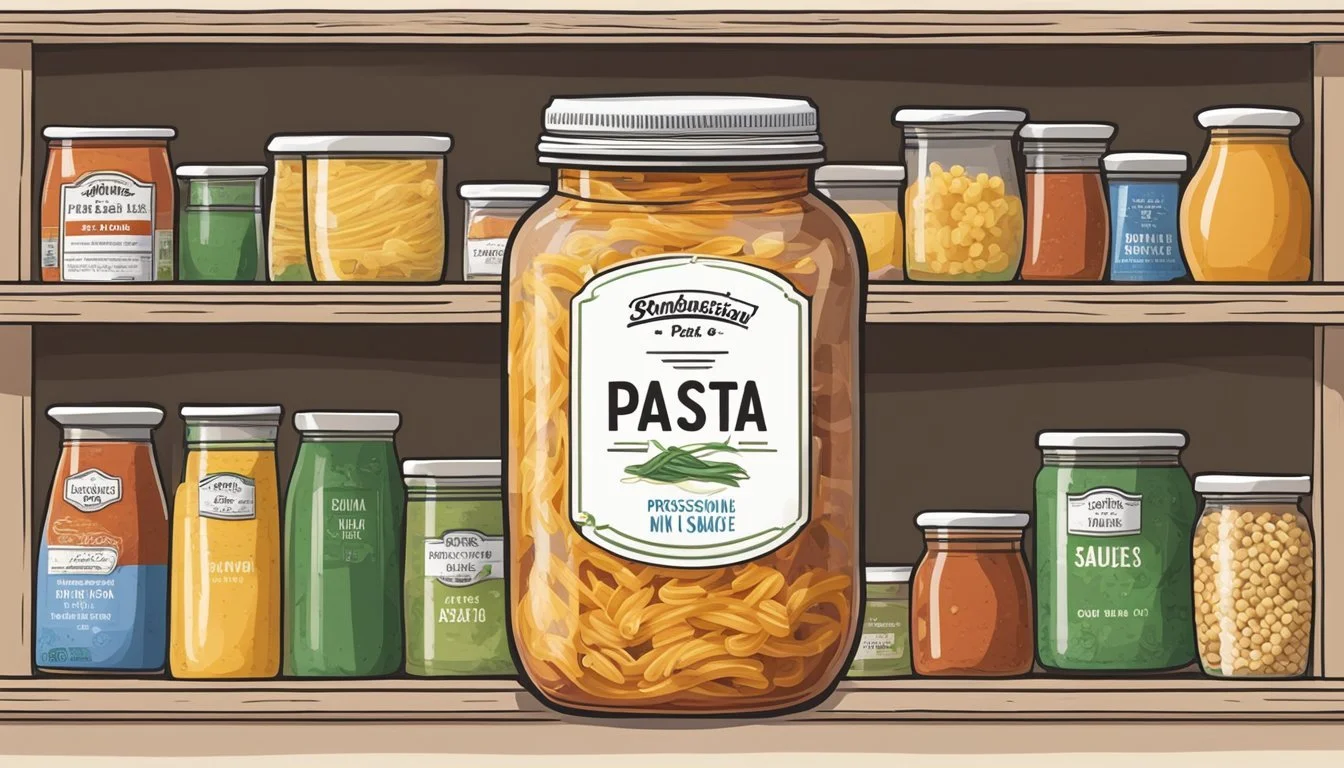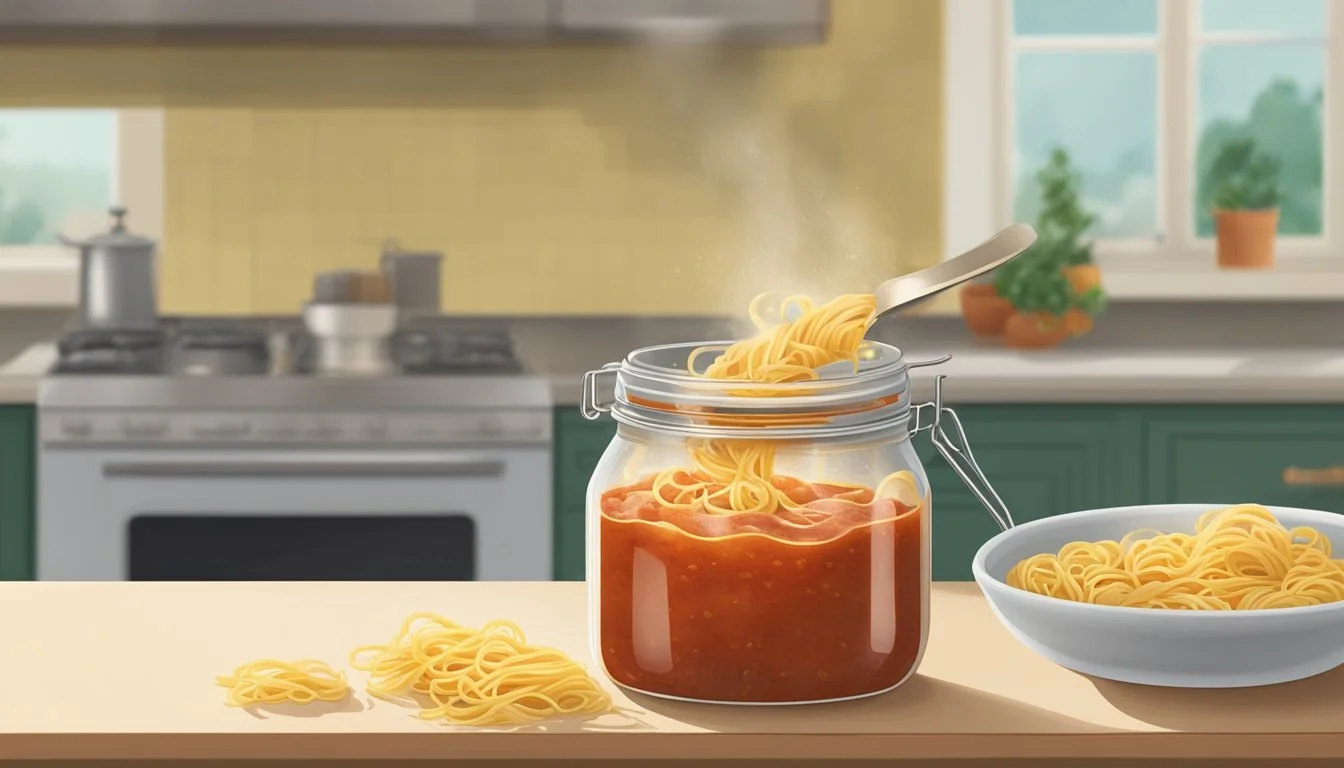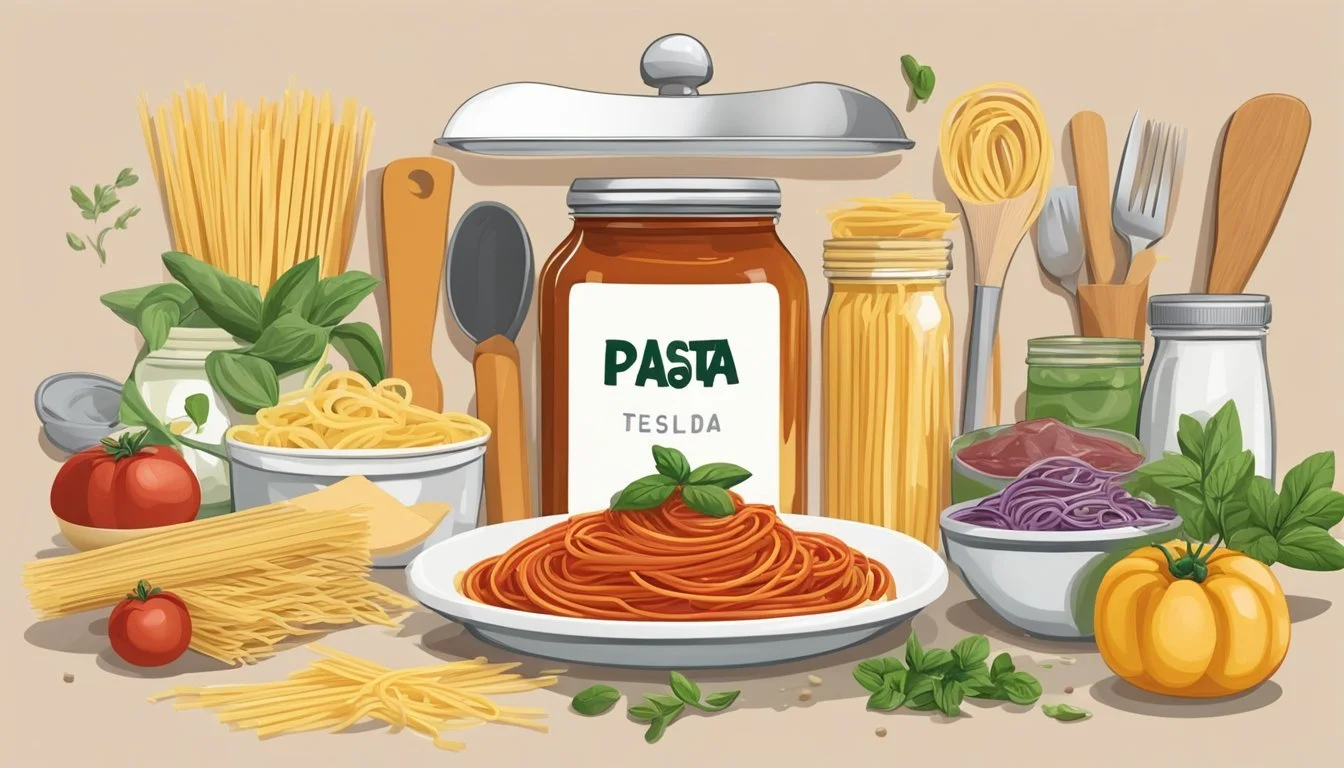How Long Does Pasta Sauce Mix Last?
Shelf Life and Storage Tips
When it comes to preserving the flavor and quality of pasta sauces, understanding their shelf life is crucial. An opened jar of pasta (What wine goes well with pasta?) sauce is safe to store in the refrigerator for about five to seven days. This time frame applies to high-acid canned foods, such as tomato-based pasta sauces, which are among the most common types. To ensure the sauce remains consumable, it should be kept in an airtight container to prevent contamination and preserve its taste.
Unopened spaghetti sauce mixes, on the other hand, can have a significantly longer shelf life. These mixes, stored in a cool, dry place, can maintain their best quality for about two years at room temperature. Despite this, it is always recommended to check the expiration date provided by the manufacturer, as it serves as a helpful guideline for determining the mix's peak quality.
Once the package is opened, the window for using the spaghetti sauce mix narrows. In the refrigerator, an opened sauce mix can last up to a week if properly stored in an airtight container. During this period, it is important to monitor the mix for any signs of spoilage before use. The freshness can be influenced by various factors, including the presence of preservatives, the brand of sauce, and how the sauce is stored post-opening.
Understanding Pasta Sauce
Pasta sauce mix, often regarded as a pantry staple, consists of dried ingredients that, when combined with water or other specified liquids, create a sauce for various pasta dishes. The shelf life of pasta sauce mix primarily depends on how it is stored.
When unopened and stored in a cool, dry place, pasta sauce mix can last up to 18 months. Proper storage conditions include avoiding exposure to heat, moisture, and light, which can degrade the quality and flavor of the sauce mix.
Once opened, transferring the pasta sauce mix to an airtight container can help maintain its freshness. If the pasta sauce mix is prepared, it should be treated like a fresh sauce. Typically, homemade or opened pasta sauce should be refrigerated and used within 5 to 7 days.
Here are key points to consider:
Unopened Shelf Life: Up to 18 months in cool, dry conditions.
Opened Shelf Life: 5 to 7 days when refrigerated.
Freezing Prepared Sauce: Up to 3 months for best quality.
Signs of Spoilage: Discoloration, off-odors, and mold indicate spoilage.
Storing Pasta Sauce Mix:
State Container Refrigerated Freezer Unopened Original packaging Not needed Not recommended Opened (dry mix) Airtight container Not needed Not recommended Prepared sauce Tightly sealed 5 to 7 days Up to 3 months
It's essential to label and date leftovers to keep track of their freshness. Always perform a sensory check for spoilage before use, regardless of the storage time.
Types of Pasta Sauce
In the vast array of Italian cuisine, pasta sauces are as diverse as they are flavorful, mainly differentiated by their base ingredients which influence both their culinary use and shelf life.
Tomato-Based Sauce
Tomato-based sauces (What wine goes well with tomato-based sauces?) are a cornerstone in pasta dishes. They mainly consist of tomatoes as the primary ingredient, seasoned with herbs and spices. Sauces like Marinara, a simple sauce with garlic, salt, and basil, are known for their use in a variety of dishes. Ingredients in these sauces are acidic, which can naturally help in preservation.
Cream-Based Sauce
For a richer flavor profile, there is the cream-based sauce category. These sauces often incorporate dairy products like milk or cream, along with butter and cheese for added richness. A well-known example is Alfredo sauce, which combines heavy cream, butter, and Parmesan cheese for a smooth and velvety finish. Dairy ingredients in cream sauces tend to have a shorter shelf life compared to acidic tomato sauces.
Pesto & Oil-Based Sauce
Diverse in their composition, pesto and oil-based sauces typically contain fresh ingredients such as basil, garlic, nuts, cheese, and are bound together by olive oil. Pesto, in particular, is a vibrant green sauce originating from Genoa and is synonymous with a fresh, herbal taste. Oil helps in preserving the ingredients to a certain extent but these sauces still lack the longevity of some tomato-based varieties due to their fresh ingredients.
Shelf Life of Pasta Sauce
The durability of pasta sauce varies significantly between unopened and opened containers. Factors such as preservatives, packaging, and storage conditions critically influence its longevity. Here's how long one can expect pasta sauce to maintain its quality.
Unopened Pasta Sauce
An unopened jar, can, or package of pasta sauce typically has a best by date or expiration date labeled by the manufacturer. This is a good indicator of how long the sauce will remain at peak quality.
Shelf Life: If stored properly in a cool, dry place, unopened pasta sauce generally lasts for about 12 to 18 months.
After Expiration: It may still be safe to consume pasta sauce after the expiration date has passed, assuming there are no signs of spoilage.
Opened Pasta Sauce
Once opened, the shelf life of pasta sauce decreases due to exposure to air, bacteria, and potential contaminants.
Refrigeration: Store opened pasta sauce in the refrigerator and aim to use it within 5 to 10 days.
Freezing: For extended preservation, one can freeze pasta sauce. Portion it into containers or freezer bags, label with the current date, and use within up to 3 months for optimal quality.
Storing Pasta Sauce
When it comes to pasta sauce, whether it is homemade or store-bought, proper storage is crucial to maintain freshness and prevent spoilage. The two primary methods for storing pasta sauce are refrigeration and freezing, each with its own set of guidelines to ensure the sauce remains safe and tasty for as long as possible.
Refrigerating Pasta Sauce
After opening, pasta sauce should be transferred to the refrigerator to prolong its shelf life. It is advised to keep the sauce in an airtight container to prevent contamination and preserve flavor. Glass jars or plastic containers with tight-fitting lids are ideal options. The recommended temperature for refrigeration is below 40°F, and the sauce should be used within 3 to 5 days for optimal quality.
Temperature: Below 40°F
Duration: 3 to 5 days
Container: Airtight (glass jars, plastic containers)
Freezing Pasta Sauce
For longer storage, freezing is an effective method. Pasta sauce can be frozen in airtight containers or freezer bags. Before sealing, make sure to remove any excess air to prevent freezer burn. Clearly label the date on the container or bag for future reference. When stored at a consistent 0°F, pasta sauce can last up to 3 months in the freezer. It is best to portion the sauce into usable amounts before freezing, as this allows for easier thawing and prevents waste.
Temperature: 0°F
Duration: Up to 3 months
Containers: Airtight (freezer bags, glass, or plastic containers)
Additional Tip: Label with date and portion before freezing
Signs of Spoilage
When assessing whether pasta sauce mix has gone bad, one should look for clear indicators of spoilage. These signs include:
Color: Fresh pasta (how long does fresh pasta last?) sauce typically has a vibrant hue. A noticeable change to a dull or darkened color suggests it may be time to discard the sauce.
Texture: The sauce's consistency can also signal spoilage. If the texture changes to something unexpected, like becoming unusually thick or separated, the sauce may be past its prime.
Odor: A healthy sauce will have a familiar, appetizing aroma. Any foul or off-putting smells are a warning that the sauce could be spoiled.
Flavor: An altered or strange taste is another sign of spoilage. If the sauce tastes off, it should not be consumed.
Mold Formation: The presence of mold, which may appear as furry patches of white, green, or black, is a definitive sign the sauce should be thrown away.
Individuals should trust their senses when checking for these signs of spoilage. If the sauce exhibits any of the above characteristics, one should err on the side of caution and avoid consumption. It's important to prioritize health and safety by recognizing these spoilage indicators to prevent potential foodborne illness.
Food Safety Considerations
When dealing with pasta sauce mix, it is imperative to consider food safety to prevent bacterial contamination and foodborne illness. Maintaining cleanliness and understanding when a product is no longer safe to consume are the cornerstones of these precautions.
Practicing Good Hygiene
One should always start with clean hands and kitchenware. The Partnership for Food Safety Education underscores the importance of washing hands for at least 20 seconds with soap and water before and after handling food. Utensils, such as spoons and ladles, should be washed in hot, soapy water after each use to prevent the transfer of bacteria to and from the sauce.
Utensils to consider:
Spoons
Ladles
Jars
Storage containers
Additionally, one should use a clean spoon each time when extracting sauce mix from its container to prevent cross-contamination.
Recognizing Foodborne Illness
The early detection of foodborne illness can minimize risks of severe symptoms. Key signs include an off odor, color change, or mold growth, which indicates bacterial activity. Food that has been stored improperly or kept past its shelf life should be disposed of immediately.
Signs of spoilt food:
Off odor
Discoloration
Visible mold
Unusual texture
One should not taste the sauce to determine its safety, as this could lead to illness. If the pasta sauce mix has been stored in a cool, dry place and shows no signs of spoilage, it is typically safe to consume.
Using Leftover Sauce
When it comes to utilizing leftover pasta sauce, proper reheating and incorporating it into new dishes are excellent strategies to reduce waste and extend the sauce's usability.
Reheating Pasta Sauce
Reheating leftover sauce is a straightforward process. One should ensure even heating to preserve flavor and safety. Microwaving is a quick method, where one can place the sauce in a microwave-safe container, cover it to prevent splattering, and heat in short intervals of 30 seconds, stirring in between until it reaches the desired temperature. It's crucial to monitor the cook time to avoid overcooking, which can lead to loss of taste and a potential burnt sauce.
Cooking with Leftover Sauce
Leftover sauce can be creatively incorporated into new meals. Here are some suggestions for cooking with leftover pasta sauce:
Transform into a soup base: Add broth or water and preferred vegetables, meats, and seasonings.
Create a pasta bake: Mix leftover sauce with pasta, top with cheese, and bake until golden.
Enhance casseroles: Layer the sauce within a casserole for added moisture and flavor.
Make a shakshuka: Simmer the sauce in a pan and crack eggs into it, allowing the eggs to poach in the sauce.
These methods not only repurpose the sauce but also add a depth of flavor to new creations. It is important to remember that one should always check the sauce for signs of spoilage before using it in any dish.
Freeze-Drying & Canning Pasta Sauce
Preserving pasta sauce effectively extends its shelf life and retains flavor. Techniques like home canning and commercial freeze-drying allow for long-term storage while maintaining the quality of the sauce.
Home Canning Techniques
Home canning is a viable method for preserving pasta sauce. Using a water bath canner or a pressure canner can keep sauce safe and flavorful for up to a year. It is critical to adhere to safe canning practices to prevent the growth of bacteria.
Essential Steps:
Prepare the sauce with or without meat, adding fresh herbs or preservatives as desired.
Sterilize canning jars and lids by boiling them in water.
Fill the jars with sauce, leaving the recommended headspace.
Apply the lids and secure the bands.
Process jars in the water bath or pressure canner for the correct time.
Note: Salt, lemon juice, or vinegar may be added to increase acidity, which is crucial for preserving the sauce's safety and quality.
Commercial Freeze-Drying
In commercial food production, freeze-drying pasta sauce results in a shelf-stable product that can last for years. The process involves deep freezing the sauce and then reducing the surrounding pressure to dehydrate the food through sublimation, nearly eliminating water content.
Advantages:
Extended Shelf Life: Sauce can be stored for a significantly longer period without spoilage.
Flavor Retention: Taste and nutritional value remain largely unchanged due to the gentle process.
No Preservatives Needed: The absence of water prevents bacterial growth without additional preservatives.
Commercial freeze-drying is not typically practical for home cooks due to the specialized equipment and technology required. However, consumers benefit from the convenience of these products with prolonged storage capabilities.
Pasta Sauce and Health
When choosing pasta sauce, one's health and dietary restrictions often guide the decision. It is important for consumers, especially those with specific health concerns like sodium intake or food allergies, to be aware of pasta sauce varieties that cater to their dietary needs.
Reduced Sodium Options
For individuals monitoring their sodium intake, reduced sodium pasta sauces are available. Such options often have a significant decrease in salt content, making them a suitable choice for those on a heart-healthy diet recommended by registered dietitians (RDs) and medical specialists (MS). Reducing sodium can help manage blood pressure and reduce the risk of cardiovascular diseases.
Gluten-Free and Allergy Considerations
Pasta sauces may sometimes contain allergens such as gluten, which are a concern for people with celiac disease or gluten sensitivity. Gluten-free pasta sauces omit ingredients like wheat, ensuring they are safe for consumption by those with these dietary restrictions. Moreover, manufacturers often highlight allergen information on labels, helping consumers make informed choices. It's crucial to read labels to avoid allergens like nuts, dairy, or soy if one has specific food sensitivities or allergies.
FAQs: Frequently Asked Questions
Q: How long can I store homemade spaghetti sauce mix?
A: Homemade spaghetti sauce properly stored in the refrigerator typically lasts 3-5 days. For extended shelf life, one can freeze the sauce, where it remains safe for up to 6 months.
Q: What is the best way to store spaghetti sauce to maximize its shelf life?
A: The optimum storage method for spaghetti sauce is in a cool, dry area before opening and in an airtight container or plastic freezer bag in the fridge or freezer after opening.
Q: Can I freeze spaghetti sauce that contains meat?
A: Yes, sauces containing meat can be frozen. Ensure the sauce has cooled before sealing it in an airtight container. Label and date the container for future reference.
Q: Are there signs to look out for that indicate spaghetti sauce has spoiled?
A: They should look for changes in color, odor, and taste. The presence of mold is a clear sign that the sauce should not be consumed.
Q: What do food safety experts recommend regarding leftover spaghetti sauce?
A: Experts typically advise that leftovers should be eaten, discarded, or frozen within four days, according to guidelines from food safety apps like the FDA’s Food Keeper.
storage tips for spaghetti sauce
Storage Location Shelf Life Pantry Unopened: Up to 1 year Refrigerator Opened: 3-5 days Freezer Opened: Up to 6 months
These guidelines should ensure both safety and quality when storing spaghetti sauce mix.








